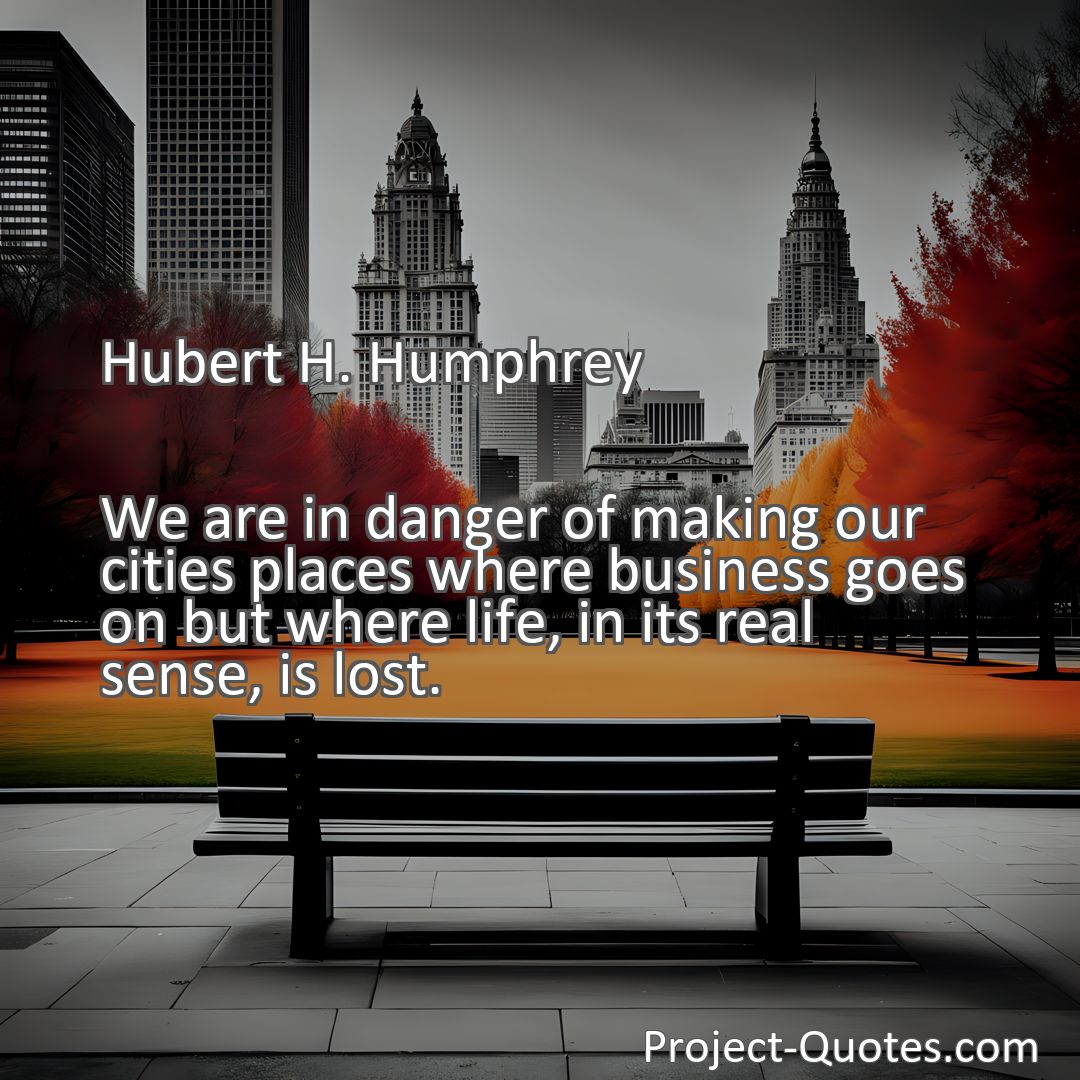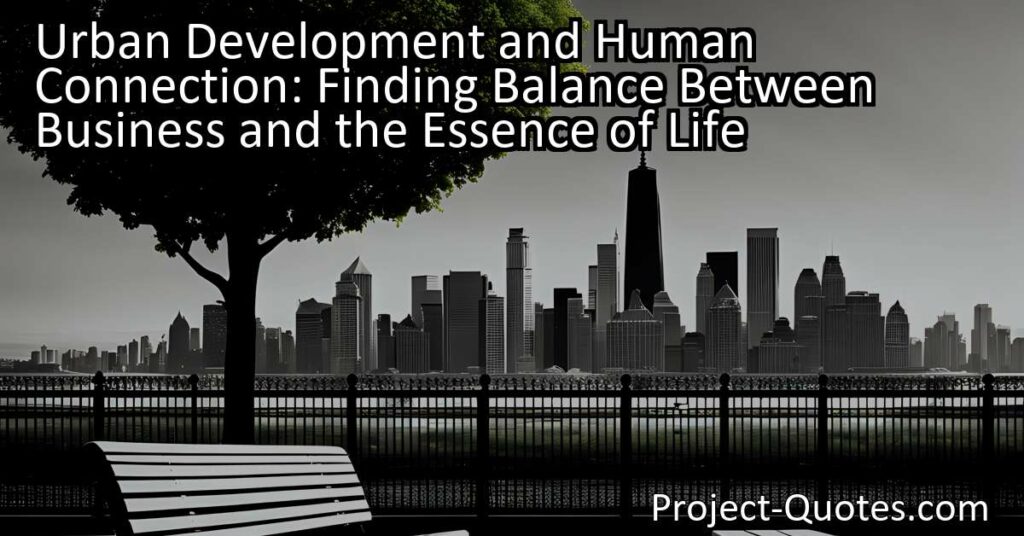We are in danger of making our cities places where business goes on but where life, in its real sense, is lost.
Hubert H. Humphrey
Urban Development and Human Connection: Striking a Balance Between Business and the Essence of Life As cities grow and focus on economic development, there is a risk of losing the essence of life itself. Urban areas need to prioritize creating spaces for leisure, preserving affordable housing, and investing in the arts to maintain a sense of community and connection. By adopting a holistic approach to urban development, cities can achieve economic prosperity while also prioritizing the well-being and quality of life for its residents.
Table of Contents
- 1 We are in danger of making our cities places where business goes on but where life, in its real sense, is lost.
- 2 Hubert H. Humphrey
- 3 Meaning of Quote – We are in danger of making our cities places where business goes on but where life, in its real sense, is lost.
- 4 Freely Shareable Quote Image
- 5 Related
Meaning of Quote – We are in danger of making our cities places where business goes on but where life, in its real sense, is lost.
Urbanization has undoubtedly shaped the way we live and interact with one another. As our cities continue to grow and expand, our focus has shifted towards economic development and the pursuit of material wealth. However, amidst this progress, we are in danger of losing something essential – the essence of life itself. This quote highlights the potential consequence of prioritizing business over the well-being and quality of life of city dwellers. In this article, we will delve deeper into this notion and explore how cities can strike a balance between economic prosperity and the preservation of the human experience.
Cities have long been centers of commerce and industry, attracting individuals seeking employment, opportunities, and a better life. As a result, urban areas have become synonymous with bustling streets, towering skyscrapers, and fast-paced lifestyles. The allure of urbanization lies in the promise of economic growth and the potential for upward mobility. However, in our haste to achieve these goals, we often overlook the importance of cultivating a sense of community and connection within these concrete jungles.
It is essential to acknowledge that cities are more than just clusters of buildings and a means to foster financial success. They are vibrant ecosystems where people from diverse backgrounds converge, bringing together a tapestry of cultures, traditions, and stories. Consequently, by solely focusing on business endeavors, we risk eroding the very fabric that makes cities so appealing and socially engaging.
One prominent area where cities often fall short is in providing spaces for leisure, relaxation, and recreation. As high-rises dominate the skyline and sprawling malls line the streets, green spaces and communal gathering spots are often sacrificed in the name of development. Parks, playgrounds, and open areas provide invaluable opportunities for individuals to unwind, connect with nature, and engage in physical activities. They serve as the backdrop for family picnics, friendly sports matches, and a respite from the concrete monotony. Without these spaces, cities can become lifeless and suffocating, depriving residents of the chance to escape the hustle and reconnect with their inner selves.
Furthermore, the focus on business-centric development can contribute to a lack of affordable housing and the displacement of lower-income communities. Gentrification, a phenomenon where affluent individuals move into traditionally working-class neighborhoods, often comes hand in hand with urbanization. While this process may result in superficial improvements to physical infrastructure, it risks pushing out long-established residents who can no longer afford to live in their own neighborhoods. Displacement disrupts social networks, separates families, and, ultimately, hampers the sense of belonging and cohesiveness within a community.
In addition to physical spaces, the soul of a city is deeply intertwined with its cultural heritage and artistic expression. However, in the relentless pursuit of economic growth, we inadvertently neglect the nurturing of artistic endeavors and cultural preservation. The historical landmarks that tell the stories of our past are replaced by shiny new developments, leaving future generations disconnected from their roots. The arts, be it through theater, music, or literature, are the lifeblood of a society, reflecting its values, beliefs, struggles, and triumphs. By sidelining artistic expressions, cities miss out on fostering creativity, innovation, and the soul-stirring experiences that enable personal growth and a deeper understanding of oneself and others.
To combat the dangers highlighted in the quote, city planners and policymakers must adopt a holistic approach to urban development. They must strike a balance between economic growth and the needs of the citizens. Creating spaces that promote well-being, community connection, and cultural preservation is pivotal to ensure cities do not become mere concrete landscapes.
One way to achieve this is through the implementation and enhancement of green infrastructure within cities. Designating areas for parks, gardens, and recreational spaces can mitigate the loss of natural elements in urban environments. Such green spaces provide opportunities for physical activity, socializing, and mental rejuvenation. Additionally, they contribute to improving air quality, reducing noise pollution, and combating the negative effects of climate change.
Another crucial aspect of urban development is the provision of affordable housing and the prevention of gentrification. Prioritizing the needs of long-term residents and implementing policies that support affordable housing initiatives can help create a diverse and inclusive city. Preserving the cultural heritage and historical buildings of a community can also foster a sense of pride, identity, and connection for residents, old and new alike.
Moreover, city officials should invest in promoting the arts and cultural activities. By allocating resources to support local artists, musicians, performers, and writers, cities become more vibrant and culturally diverse. Public art installations, museums, and theaters can become the heart of a city, attracting tourists and immersing residents in a rich tapestry of artistic expression. These spaces not only promote cultural preservation but also facilitate storytelling, dialogue, and the exchange of ideas – crucial elements that contribute to a thriving urban environment.
In conclusion, while economic growth is essential, it should not come at the expense of human connection, well-being, and cultural preservation within cities. Our cities have the potential to be dynamic and engaging spaces, where people can live, work, and truly experience life in its real sense. By prioritizing the creation of green spaces, preserving community heritage, and investing in the arts, cities can strike a balance between business and the preservation of the human spirit. It is only by embracing this holistic approach that we can ensure our cities remain vibrant and inclusive, fostering a sense of belonging and fulfillment for all its inhabitants.
I hope this quote inspired image brings you hope and peace. Share it with someone who needs it today!


